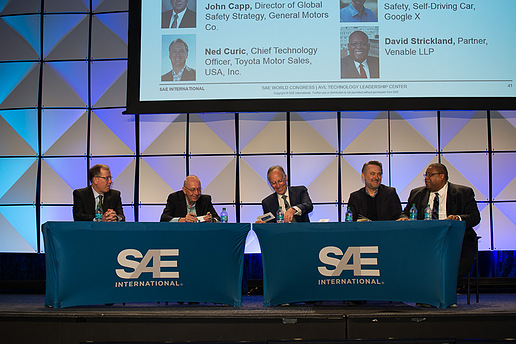 到2020年,人均“智能”设备拥有量将达到26件。届时,网络互联将广泛渗入至人类生活的方方面面,而汽车则将凭借各种IoT(物联网)系统,成为其中的主要元素。
到2020年,人均“智能”设备拥有量将达到26件。届时,网络互联将广泛渗入至人类生活的方方面面,而汽车则将凭借各种IoT(物联网)系统,成为其中的主要元素。 通用汽车全球安全策略部总监John Capp介绍了即将在2017款凯迪拉克CT6上采用的V2V通信模块,以及另一款凯迪拉克车型的“Super Cruise(超级巡航)”系统。
通用汽车全球安全策略部总监John Capp介绍了即将在2017款凯迪拉克CT6上采用的V2V通信模块,以及另一款凯迪拉克车型的“Super Cruise(超级巡航)”系统。 SAE汽车年会2020专家组包括(从左到右):通用汽车John Capp、Alphabet/谷歌Ron Medford、丰田北美工程制造公司Chuck Gulash、丰田汽车销售Ned Curic,及Venable LLP律师事务所的David Strickland。
SAE汽车年会2020专家组包括(从左到右):通用汽车John Capp、Alphabet/谷歌Ron Medford、丰田北美工程制造公司Chuck Gulash、丰田汽车销售Ned Curic,及Venable LLP律师事务所的David Strickland。
到21世纪20年代,我们的网络互联和交通运输将变成什么样子?虽然现在距离2020年仅剩短短4年时间,一组专家在SAE2016 全球汽车年会与展览(SAE 2016 World Congress)上引用了一份研究数据,大胆地预计全球网络互联设备将在2020年增长至2000亿件,人均“智能”设备拥有量将达到26件。这些设备是IoT(物联网)系统的重要组成,也是交通运输领域的关键元素。
未来,虽然我们的世界将在很大程度上实现“随时随地的互联”,主要将集中在汽车、家用电器、计算机、办公及医疗等方面。驾驶员可以通过IoT路径,随时轻松访问任何位置的任何数据。
除了谷歌(Google)等科技公司的自动驾驶汽车研发项目之外,各大汽车厂商也在积极采取各种措施,不断丰富产品的功能。大会专家组成员David Strickland曾任美国国家公路交通安全局(NHTSA)局长,目前就职于精专自动驾驶领域的Venable LLP律师事务所,负责法律法规领域的事务。他认为,如今我们的自动驾驶发展进程已经实现了四分之三。
对无人驾驶汽车的担忧
Strickland指出,随着汽车行业的不断进步,与互联相关的信息隐私问题也日益凸显。但他相信,为了“避免自己汽车成为(无法跟随技术进步浪潮的)砖头”,未来驾驶员完全有可能放弃对隐私保护的坚持,转而向自动驾驶技术敞开胸怀。
通用汽车全球安全策略部总监John Capp介绍了即将在2017款凯迪拉克CT6上采用的V2V通信模块,以及另一款凯迪拉克车型的“Super Cruise(超级巡航)”系统。据了解,通用汽车的Super Cruise系统结合采用了雷达、超声波传感器、摄像头和GPS等技术,与公司2013年发布的Driver Assist(驾驶员协助系统,即支持自动制动的适应性巡航系统)相比,新系统可以实现更多主动控制,但具体性能仍尚未公布。
虽然,通用汽车已经承认在天气恶劣、道路标记模糊及交通环境异常等情况下,SuperCruise系统的性能会受到一定影响,但并未明确指出驾驶员应当在哪些情况下完全接管汽车的驾驶,以及如何进行接管。
凯迪拉克将加入沃尔沃S90,搭配最新版半自动Pilot Assist领航辅助系统,可利用车辆的先进摄像头监测车辆周边的行人、自行车及各种动物,即使在没有前车的情况下,也能时刻确保车道的保持。据了解,该系统的可应对的最高车速为130km/h(80mph)。
Alphabet(谷歌母公司)/谷歌(Google)自动驾驶汽车项目安全总监Ron Medford指出,AAA交通安全基金会的研究结果在一定程度上反映了关于无人驾驶汽车的担忧。通用汽车的Gapp指出,虽然绝大多数驾驶员都愿意“享受自动驾驶”,但这并不能代表所有人的意愿,而汽车行业在进行设计时则必须考虑到所有用户的偏好。
Capp表示,“到时候,一定仍有驾驶员坚持驾驶‘老式’汽车”,在同一条车道上与自动驾驶汽车一起驰骋,“我们也只能接受这样的现实。”
DSRC即将进入零部件市场?
在这种情况下,即使不能完全融入自动驾驶的世界,但汽车零部件市场最起码也应该为“老式”汽车提供改装服务,为其配备可以产生交通信息的设备,从而便利这种“老式”汽车与自动驾驶车辆之间的互动。如今,汽车零部件市场中的很多高级广播均配备了DSRC功能(专用短程通信技术),可利用交通运输专用频率5.9Ghz进行通信,但目前仅在一些自动公路收费设施上有所应用。如果充分发挥作用,这种技术还可用于汽车与交通监测基础设施之间的通信。
丰田汽车美国销售公司首席技术官Ned Curic表示,虽然未来的驾驶员普遍可以享受相当高级别的互联移动性,Lyft等驾乘分享服务也将进一步巩固自己的地位,但“千禧一代非常不同。”他解释说,这部分用户希望拥有属于自己的汽车,也想亲自驾驶高科技车型,因此他们对自动驾驶世界的贡献相对有限。
此外,汽车零部件市场在DSRC系统之外的作用也并不确定。Cruise Automation等公司开始尝试通过安装套装,将奥迪车型改装为自动驾驶汽车。不过,这种做法已经逐渐被另一种不断发展自动驾驶技术的思路所取代,后者可以更为广泛地应用至更多车型。目前,这家初创公司即将被通用汽车公司收购。
作者:Paul Weissler
来源:SAE《汽车工程》杂志
翻译:SAE上海办公室
2016 SAE Congress: Fear of the driverless car as 2020 approaches
What will connectivity and mobility be like in the 2020s? Although the start of the decade is less than four years away, an expert panel at the 2016 SAE World Congress cited research that sees 200 billion devices online and connected—26 "smart" objects per human—that will constitute the Internet of Things (IoT) and form a key element of new mobility platforms.
The connections will be omnipresent and although the focus may be on the automobile, home, computer, work and health-related connections also will be made. And the motorist will have IoT-enabled access to whatever data is available, anywhere.
Efforts by Google and others to develop self-driving vehicles aside, the major OEMs are taking evolutionary steps to more full-function versions. The present level of technology is three-quarters of the way to a self-driving car, claimed panelist David Strickland, former NHTSA administrator who is a member of law firm Venable LLPspecializing in the regulatory area.
Fear of the driverless car
Strickland pointed to the privacy issues that are arising as the evolution continues. But he expressed confidence that motorists will see sufficient incentives to give up privacy "to avoid the car becoming a [technologically obsolete] brick."
John Capp, GM's Director of Global Safety Strategy, pointed to the forthcoming installations of a V2V module on the 2017 Cadillac CT6 and "Super Cruise" on an unnamed other Cadillac model. Super Cruise is GM's fusion of radar, ultrasonic sensors, cameras and GPS. It represents more active control, derived from the Driver Assist package (adaptive cruise with automatic braking) introduced in 2013, but the performance specifications are yet to be revealed.
Although GM has mentioned limitations for poor weather, illegible lane markings and unusual traffic issues, it has not defined the conditions under which, and how, motorists would be expected to assume full control.
Cadillac will join the Volvo S90, with its latest version of Pilot Assist, a semi-autonomous system with advanced camera detection of pedestrians, cyclists and animals, that controls steering to keep the car in lane even without a vehicle ahead to track. It operates up to 80 mph/130 km/h.
Alphabet/Google's Ron Medford, director of safety for the company's self-driving car project, pointed to an AAA study that showed considerable fear of driverless cars. And GM's Capp noted that although "enjoying hands free" is for many drivers, it isn't for all, and the industry will have to design cars so they can be used the way the motorist wants, when he wants it.
"There'll be guys driving around with old cars" on the same roads as autonomous vehicles, Capp said, "and we'll just have to deal with that."
Aftermarket DSRC coming?
One possibility is that the aftermarket at least could contribute to an autonomous-driving world with cars retrofitted to produce traffic information, if not capable of more complete participation. Many premium aftermarket radios are equipped with DSRC capability (digital short range communication, the 5.9 GHz band set aside for traffic function, and presently used only for automated toll collection). If enabled, they could communicate with a traffic monitoring infrastructure.
Ned Curic, Toyota Motor Sales USA's chief technology officer, said that although the motorist's level of connectivity will be pervasive and ride-sharing systems like Lyft are taking hold, "millennials are very different." They do want to own cars, he said, and they want to drive more technologically advanced models, so their level of participation in autonomous drive may be limited.
The automotive aftermarket's role in the picture beyond DSRC also is uncertain. Companies like Cruise Automation, a startup in the process of being acquired by GM, began with the idea of converting Audi models to autonomous drive with installation of a kit. That idea is being supplanted with one to perfect self-driving technology for a broad range of vehicles.
Author: Paul Weissler
Source: SAE Automotive Engineering Magazine
等级
打分
- 2分
- 4分
- 6分
- 8分
- 10分
平均分
- 作者:Paul Weissler
- 行业:汽车
- 主题:安全性人体工程学/人因工程学电气电子与航空电子
